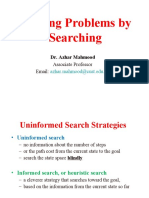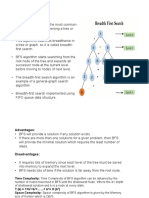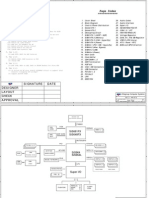Unit 3 Informed and Uninformed Search
Uploaded by
ashpoudel67Unit 3 Informed and Uninformed Search
Uploaded by
ashpoudel67A problem is defined by:
– An initial state: State from which agent start
– Successor function: Description of possible actions available to the agent.
– Goal test: Determine whether the given state is goal state or not
– Path cost: Sum of cost of each path from initial state to the given state.
A solution is a sequence of actions from initial to goal state. Optimal solution has the lowest path
cost.
Problem Solving by Searching
Problem solving is the systematic search through a range of possible states in order to reach
Some predefined goal. A problem solving has following steps.
Four general steps in problem solving:
– Goal formulation
– What are the successful world states
– Problem formulation
– What actions and states to consider given the goal
– Search
– Determine the possible sequence of actions that lead to the states of known values and
then choosing the best sequence.
– Execute
– Give the solution, performs the actions.
A search problem
Figure below contains a representation of a map. The nodes represent cities, and the links
represent direct road connections between cities.
The search problem is to find a path from a city J to a city G
Fig. graph representation of a map
Prepared by: Gopi Prajapati
There are two broad classes of search methods:
- Uninformed (or blind) search methods
- Heuristic (informed) search methods
In the case of the uninformed search methods the order in which potential solution paths are
considered is arbitrary, using no domain-specific information to judge where the solution is likely to
lie.
In the case of the heuristically informed search methods one uses domain-dependent (heuristic)
information in order to search the space more efficiently.
Measuring problem Solving Performance
We will evaluate the performance of a search algorithm in four ways
• Completeness
– An algorithm is said to be complete if it definitely finds solution to the problem, if exist.
• Time Complexity
– How long (worst or average case) does it take to find a solution? Usually measured in terms of the
number of nodes expanded
• Space Complexity
– How much space is used by the algorithm? Usually measured in terms of the maximum number
of nodes in memory at a time
• Optimality/Admissibility
– If a solution is found, is it guaranteed to be an optimal one? For example, is it the one with
minimum cost?
Uninformed search (Blind search)
It has only goal state and initial state. No other additional information is provided like the cost of
path and no domain specific information. It search the potential solution in some arbitrary
direction.
Breadth First Search (BFS)
Looks for the goal node among all the nodes at a given level before using the children of those
nodes to Expand shallowest unexpanded node
Fringe is implemented as a FIFO queue.
Note: Fringe is a generated but unexpanded node. Fringe is the border obtained by connecting all
the nodes at the end of each path.
Prepared by: Gopi Prajapati
BFS evaluation
Completeness:
– Does it always find a solution if one exists?
– YES
– If shallowest goal node is at some finite depth d and If b is finite
Time complexity:
– Assume a state space where every state has b successors.
– root has b successors, each node at the next level has again b successors (total b2), …
– Assume solution is at depth d
– Worst case; expand all except the last node at depth d
– Total no. of nodes generated:
b + b2 + b3 + ………………….. bd + ( bd+1 –b) = O(bd+1)
Space complexity:
– Each node that is generated must remain in memory
– Total no. of nodes in memory:
1+ b + b2 + b3 + ………………….. bd + ( bd+1 –b) = O(bd+1)
Optimality (i.e., admissible):
– if all paths have the same cost. Otherwise, not optimal but finds solution with shortest path
length (shallowest solution). If each path does not have same path cost shallowest solution may
not be optimal
Prepared by: Gopi Prajapati
BFS pseudocode
create a queue Q
mark v as visited and put v into Q
while Q is non-empty
remove the head u of Q
mark and enqueue all (unvisited) neighbours of u
Two lessons:
– Memory requirements are a bigger problem than its execution time.
– Exponential complexity search problems cannot be solved by uninformed search methods for
any but the smallest instances.
DEPTH2 NODES TIME MEMORY
2 1100 0.11 seconds 1 megabyte
4 111100 11 seconds 106 megabytes
6 107 19 minutes 10 gigabytes
8 109 31 hours 1 terabyte
10 1011 129 days 101 terabytes
12 1013 35 years 10 petabytes
14 1015 3523 years 1 exabyte
Uniform Cost Search
Uniform Cost Search is the best algorithm for a search problem, which does not involve the use
of heuristics. It can solve any general graph for optimal cost. Uniform Cost Search as it sounds
searches in branches which are more or less the same in cost.
Uniform Cost Search again demands the use of a priority queue. Recall that Depth First Search
used a priority queue with the depth upto a particular node being the priority and the path from
the root to the node being the element stored. The priority queue used here is similar with the
priority being the cumulative cost upto the node. Unlike Depth First Search where the maximum
Prepared by: Gopi Prajapati
depth had the maximum priority, Uniform Cost Search gives the minimum cumulative cost the
maximum priority.
Depth First Search (DFS)
Looks for the goal node among all the children of the current node before using the sibling of
this node
Expand deepest unexpanded node
Fringe is implemented as a LIFO queue (=stack)
Prepared by: Gopi Prajapati
DFS evaluation
Completeness;
– Does it always find a solution if one exists?
– NO
– If search space is infinite and search space contains loops then DFS may not find solution.
Time complexity;
– Let m is the maximum depth of the search tree. In the worst case Solution may exist at depth
m.
– root has b successors, each node at the next level has again b successors (total b2), …
– Worst case; expand all except the last node at depth m
– Total no. of nodes generated:
b + b2 + b3 + ………………….. bm = O(bm)
Space complexity:
– It needs to store only a single path from the root node to a leaf node, along with remaining
unexpanded sibling nodes for each node on the path.
– Total no. of nodes in memory:
1+ b + b + b + ………………….. b m times = O(bm)
Prepared by: Gopi Prajapati
Optimal (i.e., admissible):
– DFS expand deepest node first, if expands entire let sub-tree even if right sub-tree contains
goal nodes at levels 2 or 3. Thus we can say DFS may not always give optimal solution.
DFS(G, u)
u.visited = true
for each v ∈ G.Adj[u]
if v.visited == false
DFS(G,v)
init() {
For each u ∈ G
u.visited = false
For each u ∈ G
DFS(G, u)
}
Depth-limited search
It makes arbitrary depth limit l and makes DFS upto that limit. It means nodes at depth l are
treated as if they have no successor and after this limit no nodes are visited.
It is DF-search with depth limit l. Solves the infinite-path problem of DFS. Yet it introduces
another source of problem if we are unable to find good guess of l. Let d is the depth of
shallowest solution.
If l < d then incompleteness results.
If l > d then not optimal.
Time complexity: O ( bl )
Space complexity: O ( bl )
Prepared by: Gopi Prajapati
Prepared by: Gopi Prajapati
Iterative deepening search
– A general strategy to find best depth limit l.
– Goals is found at depth d, the depth of the shallowest goal-node.
– Often used in combination with DF-search
– Combines benefits of DFS and BFS
– It does this by gradually increasing the limit—first 0, then 1, then 2, and so on until the goal is
found. This will occur when depth d is reached: that is depth of shallowest goal node.
Limit = 0
Limit = 1
Limit = 2
Prepared by: Gopi Prajapati
Limit = 3
ID search evaluation
Completeness:
– YES (no infinite paths)
Time complexity:
– Algorithm seems costly due to repeated generation of certain states.
– Node generation:
level d: once
level d-1: 2
level d-2: 3
…
level 2: d-1
level 1: d
– Total no. of nodes generated:
d.b +(d-1). b2 + (d-2). b3 + …………………..+1. bd = O(bd)
Space complexity:
– It needs to store only a single path from the root node to a leaf node, along with remaining
unexpanded sibling nodes for each node on the path.
– Total no. of nodes in memory:
Prepared by: Gopi Prajapati
1+ b + b + b + ………………….. b d times = O(bd)
Optimality:
– YES if path cost is non-decreasing function of the depth of the node.
Note:-
Notice that BFS generates some nodes at depth d+1, whereas IDS does not. The result is that IDS
is actually faster than BFS, despite the repeated generation of node.
Example:
Num. of nodes generated for b=10 and d=5 solution at far right
N(IDS) = 50 + 400 + 3000 + 20000 + 100000 = 123450
N(BFS) = 10 + 100 + 1000 + 10000 + 100000 + 999990 = 1111100
Drawbacks of uniformed search :
1. Criterion to choose next node to expand depends only on a global criterion: level.
2. Does not exploit the structure of the problem.
3. One may prefer to use a more flexible rule, that takes advantage of what is being
discovered on the way, and hunches about what can be a good move.
4. Very often, we can select which rule to apply by comparing the current state and the
desired state
Informed Search (Heuristic Search)
In addition to initial state and goal state, Heuristic Search uses domain-dependent (heuristic)
information like estimated path cost from initial state to goal state in order to search the space
more efficiently. Heuristic function is the estimated cost that defines the goodness of a node to
be expanded next. This allows to search in best path. It does this by deciding which node to
expand next, instead of doing the expansion in a strictly breadth-first or depth-first order. It can
discard or prune certain nodes from search space also.
Ways of using heuristic information:
• Deciding which node to expand next, instead of doing the expansion in a strictly breadth-first
or depth-first order;
• In the course of expanding a node, deciding which successor or successors to generate, instead
of blindly generating all possible successors at one time;
• Deciding that certain nodes should be discarded, or pruned, from the search space.
Prepared by: Gopi Prajapati
Best-First Search
Idea: use an evaluation function f(n) that gives an indication of which node to expand next for
each node.
– usually gives an estimate to the goal.
– the node with the lowest value is expanded first.
A key component of f(n) is a heuristic function, h(n),which is a additional knowledge of the
problem.
There is a whole family of best-first search strategies, each with a different evaluation function.
Typically, strategies use estimates of the cost of reaching the goal and try to minimize it.
Special cases: based on the evaluation function.
– Greedy best-first search
– A*search
Greedy Best First Search
Greedy best first search expands the node that seems to be closest to the goal node. Heuristic
function is used to estimate which node is closest to the goal node. It doest not always gives
optimal solution. Optimality of the solution depends upon how good our heuristic is. Once the
greedy best first search takes a node, it never looks backward.
Heuristic used by Greedy Best First Search is:
f(n) = h(n)
Where h(n) is the estimated cost of the path from node n to the goal node.
For example consider the following graph:
Prepared by: Gopi Prajapati
Prepared by: Gopi Prajapati
Prepared by: Gopi Prajapati
Evaluation Greedy Search
Completeness:
– While minimizing the value of heuristic greedy may oscilate between two nodes. Thus it is not
complete.
Optimality:
– Greedy search is not optimal. Same as DFS.
Time complexity:
– In worst case Greedy search is same as DFS therefore it’s time complexity is O(bm).
Space Complexity:
– Space complexity of DFS is O(bm). No nodes can be deleted from memory.
A * Search
Like all informed search algorithms, it first searches the routes that appear to be most likely to
lead towards the goal. What sets A* apart from a greedy best-first search is that it also takes the
distance already traveled into account (the g(n) part of the heuristic is the cost from the start, and
not simply the local cost from the previously expanded node).The algorithm traverses various
paths from start to goal. Evaluation function used by A* search algorithm is
f(n) = h(n) + g(n)
Where:
g(n): the actual shortest distance traveled from initial node to current node
h(n): the estimated (or "heuristic") distance from current node to goal
f(n): the sum of g(n) and h(n)
For example consider the following graph
Prepared by: Gopi Prajapati
Evaluating A* Search:
Completeness:
– Yes A* search always gives us solution
Optimality:
– A* search gives optimal solution when the heuristic function is admissible heuristic.
Time complexity:
– Exponential with path length i.e. O(bd) where d is length of the goal node from start node.
Space complexity:
– It keeps all generated nodes in memory. Hence space is the major problem not time
Admissible heuristic
A heuristic function is said to be admissible heuristic if it never overestimates the cost to reach to
the goal.
i.e
h(n) ≤ h*(n)
Where
h(n) = Estimated cost to reach to the goal node from node n
h*(n) = Actual cost to reach to the goal node from node n
Formulating admissible heuristics:
n is a node
h is a heuristic
h(n) is cost indicated by h to reach a goal from n
C(n) is the actual cost to reach a goal from n
h is admissible if
For Example: 8-puzzle
Figure shows 8-puzzle start state and goal state. The solution is 26 steps long.
h1(n) = number of misplaced tiles
h2(n) = sum of the distance of the tiles from their goal position (not diagonal).
h1(S) = ? 8
h2(S) = ? 3+1+2+2+2+3+3+2 = 18
hn(S) = max{h1(S), h2(S)}= 18
Prepared by: Gopi Prajapati
Consistency ( Monotonicity )
A heuristic is said to be consistent if for any node N and any successor N’ of N , estimated cost
to reach to the goal from node N to goal node is less than the sum of step cost from N to N’ and
estimated cost from node N’ to goal node.
i.e
h(n) ≤ d(n, n’) + h(n’)
Where
h(n) = Estimated cost to reach to the goal node from node n
d(n, n’) = actual cost from n to n’
#Prove that A* search gives optimal solution when the heuristic is admissible.
Suppose suboptimal goal G2 in the queue.
Let n be an unexpanded node on a shortest to optimal goal G and C* be the cost of optimal goal
node.
f(G2 ) = h (G2) + g(G2 )
f(G2 ) = g(G2) since h(G2 )=0
f(G2 ) > C* …………..(1)
Again
Since h(n) is admissible, It doesn't not overestimates the cost of completing the solution path.
Prepared by: Gopi Prajapati
=> f(n) = g(n) + h(n) ≤C* ……………(2)
Now from (1) and (2)
f(n) ≤ C* < f(G2)
Since f(G2) > f(n), A* will never select G2 for expansion. Thus A* gives us optimal solution
when heuristic function is admissible.
# Prove that: If h(n) is consistent , then the values of f(n) along the path are non-decreasing.
Suppose n’ is successor of n, then
g(n’) = g(n) + C(n,a,n’)
we know that,
f(n’) = g(n’) + h(n’)
f(n’) = g(n) + C(n,a,n’) + h(n’) …………….(1)
A heuristic is consistent if
h(n) ≤ C(n,a,n’) + h(n’)……………………(2)
Now from (1) and (2)
f(n’) = g(n) + C(n,a,n’) + h(n’) ≥ g(n) + h(n) = f(n)
Hill climbing
Hill climbing is depth-first search with a heuristic measurement that orders choices as nodes are
expanded. It always selects the most promising successor of the node last expanded.
In this search method, we start with a partial solution and try to improve it for better solution
Prepared by: Gopi Prajapati
iteratively. For eg we start N queen problem with certain configuration and try to reduce
conflicts by moving the queen iteratively so that conflicts are reduced and finally no conflicts.
The iteration goes on until we get worse solution than the previous solution.
The relative simplicity of the algorithm makes it a popular first choice amongst optimizing
algorithms.
Hill climbing can often produce a better result than other algorithms when the amount of time
available to perform a search is limited, such as with real-time systems, so long as a small
number of increments typically converges on a good solution (the optimal solution or a close
approximation).
Prepared by: Gopi Prajapati
Example:
From the graph, S moves to B because it seems much closer to the goal than A (cost doesn't
matter). A and C seems equi-distance, so goes to the A by heuristics. Then to D and finally G.
Prepared by: Gopi Prajapati
Note:
The difference between the hill climbing search method and the best first search method is the
following one:
- the best first search method selects for expansion the most promising leaf node of the current
search tree;
- the hill climbing search method selects for expansion the most promising successor of the node
last expanded.
Problems with Hill Climbing
Hill climbing cannot reach the optimal/best state (global maximum) if it enters any of the
following regions:
Local maximum: At a local maximum all neighboring states have a value which is worse than
the current state. Since hill climbing uses greedy approach, it will not move to the worse state
and terminate itself. The process will end even though a better solution may exist. Ridge is a
sequence of local maxima
To overcome local maximum problem: Utilize backtracking technique. Maintain a list of
visited states. If the search reaches an undesirable state, it can backtrack to the previous
configuration and explore a new path.
Plateau: This is an area where the search space is flat so that all neighbors return the same
evaluation. On plateau all neighbors have same value. Hence, it is not possible to select the best
direction.
To overcome plateaus: Make a big jump. Randomly select a state far away from current state.
Chances are that we will land at a non-plateau region
Ridge: Any point on a ridge can look like peak because movement in all possible directions is
downward. Hence the algorithm stops when it reaches this state.
Prepared by: Gopi Prajapati
Ridges are a challenging problem for hill climbers that optimize in continuous spaces. Because
hill climbers only adjust one element in the vector at a time, each step will move in an axis-
aligned direction. If the target function creates a narrow ridge that ascends in a non-axis-aligned
direction (or if the goal is to minimize, a narrow alley that descends in a non-axis-aligned
direction), then the hill climber can only ascend the ridge (or descend the alley) by zig-zagging.
If the sides of the ridge (or alley) are very steep, then the hill climber may be forced to take very
tiny steps as it zig-zags toward a better position. Thus, it may take an unreasonable length of
time for it to ascend the ridge (or descend the alley).
To overcome Ridge: In this kind of obstacle, use two or more rules before testing. It implies
moving in several directions at once.
Prepared by: Gopi Prajapati
Means-ends analysis (MEA)
Means-ends analysis (MEA) is a problem solving technique used commonly in artificial
intelligence (AI) for limiting search in AI programs
With MEA, it is possible to control the entire process of problem solving. It starts from a
predetermined goal, in which actions are chosen that lead to that goal. Each action that is
executed leads to the next action; everything is connected together in order to reach the end-goal.
In the meantime however, problems may arise. It is often hard to determine where exactly the
crux (point of difficulty) is. With the help of Means End Analysis, both forward and backward
research can be done to determine where the stagnation (state without flow or movement) is
occurring. This enables the larger parts of a problem to be solved first, to subsequently return to
the smaller problems afterwards.
Monkey Banana Problem
The monkey and banana problems is a famous toy problem in artificial intelligence, particularly
in logic programming and planning.
A monkey is in a room. Suspended from the ceiling is a bunch of bananas, beyond the monkey's
reach. However, in the room there are also a chair and a stick. The ceiling is just the right height
so that a monkey standing on a chair could knock the bananas down with the stick. The monkey
knows how to move around, carry other things around, reach for the bananas, and wave a stick in
the air. What is the best sequence of actions for the monkey?
There are many applications of this problem. One is as a toy problem for computer science.
Another possible purpose of the problem is to raise the question: Are monkeys intelligent?
Both humans and monkeys have the ability to use mental maps to remember things like where to
go to find shelter, or how to avoid danger. They can also remember where to go to gather food
and water, as well as how to communicate with each other.
Simulated Annealing
It is motivated by the physical annealing process in which material is heated and slowly cooled
into a uniform structure. Compared to hill climbing the main difference is that SA allows
downwards steps. Simulated annealing also differs from hill climbing in that a move is selected
at random and then decides whether to accept it. If the move is better than its current position
then simulated annealing will always take it. If the move is worse (i.e. lesser quality) then it will
be accepted based on some probability. The probability of accepting a worse state is given by the
equation
P = exp(-c /t) > r
Where
c = the change in the evaluation function
t = the current value
Prepared by: Gopi Prajapati
r = a random number between 0 and 1
The probability of accepting a worse state is a function of both the current value and the change
in the cost function. The most common way of implementing an SA algorithm is to implement
hill climbing with an accept function and modify it for SA.
Game Search
Games are a form of multi-agent environment
– What do other agents do and how do they affect our success?
– Cooperative vs. competitive multi-agent environments.
– Competitive multi-agent environments give rise to adversarial search often known as games
Games – adversary
– Solution is strategy (strategy specifies move for every possible opponent reply).
– Time limits force an approximate solution
– Evaluation function: evaluate ―goodness‖ of game position
– Examples: chess, checkers, Othello, backgammon
Difference between the search space of a game and the search space of a problem: In the first
case it represents the moves of two (or more) players, whereas in the latter case it represents the
"moves" of a single problem-solving agent
A game can be formally defined as a kind of search problem as below:
– Initial state: It includes the board position and identifies the players to move.
– Successor function: It gives a list of (move, state) pairs each indicating a legal move and
resulting state.
– Terminal test: This determines when the game is over. States where the game is ended are
called terminal states.
– Utility function: It gives numerical value of terminal states. E.g. win (+1), loose (-1) and draw
(0). Some games have a wider variety of possible outcomes eg. ranging from +92 to -192.
An exemplary game: Tic-tac-toe
There are two players denoted by X and O. They are alternatively writing their letter in one of
the 9 cells of a 3 by 3 board. The winner is the one who succeeds in writing three letters in line.
The game begins with an empty board. It ends in a win for one player and a loss for the other, or
possibly in a draw.
A complete tree is a representation of all the possible plays of the game. The root node is the
initial state, in which it is the first player's turn to move (the player X).
The successors of the initial state are the states the player can reach in one move, their successors
are the states resulting from the other player's possible replies, and so on.
Terminal states are those representing a win for X, loss for X, or a draw.
Prepared by: Gopi Prajapati
Each path from the root node to a terminal node gives a different complete play of the game.
Figure given below shows the initial search space of Tic-Tac-Toe.
Figure: Partial game tree for Tic-Tac-Toe
The min-max Algorithm
Min-max algorithm allows us to determine the best move that maximizes the winning situation
of a player. This algorithm assumes the zero sum game. If a player A is trying to maximize the
cost then other player tries to minimize the cost. The game must be adversary. It means no player
makes wrong move. In min-max algorithm we look ahead for some states and construct the game
tree. Each node in the game tree represents the various situations in the game. There may be two
types of nodes namely max and min node. Let max node represent the turn of player A and min
node represents the turn of Player B. Max node always backs off with the maximum value of its
children and min node backs off minimum value of its children. At the terminal of game tree,
some heuristics is assigned. The heuristics is goodness for the player A for winning the game.
After this we traverse the tree in DFS manner and values are backed off by min and max nodes
according to their purpose up to the root node. The Player A then takes the move which
maximizes the its winning situation.
Prepared by: Gopi Prajapati
Let us assign the following values for the game: 1 for win by X, 0 for draw, -1 for loss by X.
Given the values of the terminal nodes (win for X (1), loss for X (-1), or draw (0)), the values of
the non-terminal nodes are computed as follows:
- the value of a node where it is the turn of player X to move is the maximum of the values of its
successors (because X tries to maximize its outcome);
- the value of a node where it is the turn of player O to move is the minimum of the values of its
successors (because O tries to minimize the outcome of X).
Figure below shows how the values of the nodes of the search tree are computed from the values
of the leaves of the tree.
The values of the leaves of the tree are given by the rules of the game:
• 1 if there are three X in a row, column or diagonal;
• -1 if there are three O in a row, column or diagonal;
• 0 otherwise
Prepared by: Gopi Prajapati
Alpha-beta pruning
We can increase the performance of max-min algorithm by using alpha beta pruning. Alpha-beta
pruning is a technique for evaluating nodes of a game tree that eliminates unnecessary
evaluations. The maximum value backed off by max node from all its children, is taken as alpha
value and minimum value backed off by min node from all its children is taken as beta. Alpha
bound of a min node J is the maximum value of all max ancestors nodes of J. Beta bound of a
max node K is the min value of all ancestors of K. We keep on updating alpha and beta bounds
for min and max nodes as different values are backed off when we make DFS search by min and
max nodes. The exploration of max node or min node is stopped when alpha>=beta.
An alpha cutoff
To apply this technique, one uses a parameter called alpha that represents a lower bound for the
achievement of the Max player at a given node.
Let us consider that the current board situation corresponds to the node A in the following figure.
The minimax method uses a depth-first search strategy in evaluating the descendants of a node. It
will therefore estimate first the value of the node B. Let us suppose that this value has been
evaluated to 15, either by using a static evaluation function, or by backing up from descendants
omitted in the figure. If Max will move to B then it is guaranteed to achieve 15. Therefore 15 is a
lower bound for the achievement of the Max player (it may still be possible to achieve more,
depending on the values of the other descendants of A). Therefore, the value of α at node B is 15.
This value is transmitted upward to the node A and will be used for evaluating the other possible
moves from A.
Prepared by: Gopi Prajapati
To evaluate the node C, its left-most child D has to be evaluated first. Let us assume that the
value of D is 10 (this value has been obtained either by applying a static evaluation function
directly to D, or by backing up values from descendants omitted in the figure). Because this
value is less than the value of α, the best move for Max is to node B, independent of the value of
node E that need not be evaluated. Indeed, if the value of E is greater than 10, Min will move to
D which has the value 10 for Max. Otherwise, if the value of E is less than 10, Min will move to
E which has a value less than 10. So, if Max moves to C, the best it can get is 10, which is less
than the value α = 15 that would be gotten if Max would move to B. Therefore, the best move for
Max is to B, independent of the value of E. The elimination of the node E is an alpha cutoff.
One should notice that E may itself have a huge sub tree. Therefore, the elimination of E means,
in fact, the elimination of this sub tree.
A beta cutoff
To apply this technique, one uses a parameter called beta that represents an upper bound for the
achievement of the Max player at a given node.
In the above tree, the Max player moved to the node B. Now it is the turn of the Min player to
decide where to move:
Figure: Illustration of the beta cut-off.
The Min player also evaluates its descendants in a depth-first order.
Let us assume that the value of F has been evaluated to 15. From the point of view of Min, this is
an upper bound for the achievement of Min (it may still be possible to make Min achieve less,
depending of the values of the other descendants of B). Therefore the value of β at the node F is
Prepared by: Gopi Prajapati
15. This value is transmitted upward to the node B and will be used for evaluating the other
possible moves from B.
To evaluate the node G, its left-most child H is evaluated first. Let us assume that the value of H
is 25 (this value has been obtained either by applying a static evaluation function directly to H, or
by backing up values from descendants omitted in the figure). Because this value is greater than
the value of β, the best move for Min is to node F, independent of the value of node I that need
not be evaluated. Indeed, if the value of I is v ≥ 25, then Max (in G) will move to I. Otherwise, if
the value of I is less than 25, Max will move to H. So in both cases, the value obtained by Max is
at least 25 which is greater than β (the best value obtained by Max if Min moves to F).
Therefore, the best move for Min is at F, independent of the value of I. The elimination of the
node I is a beta cutoff.
One should notice that by applying alpha and beta cut-off, one obtains the same results as in the
case of mini-max, but (in general) with less effort. This means that, in a given amount of time,
one could search deeper in the game tree than in the case of mini-max.
Game of chance
A game of chance is a game whose outcome is strongly influenced by some randomizing device,
and upon which contestants may choose to wager money or anything of monetary value.
Common devices used include dice, spinning tops, playing cards, roulette wheels, or numbered
balls drawn from a container. A game of chance may have some skill element to it, however,
chance generally plays a greater role in determining the outcome than skill. A game of skill, on
the other hand, also may have elements of chance, but with skill playing a greater role in
determining the outcome.
Examples: card playing, dice rolling, coin flipping, gambling games
Game Theory
Game theory is a framework for hypothetical social situations among competing players. In some
respects, game theory is the science of strategy, or at least the optimal decision-making of
independent and competing actors in a strategic setting. The key pioneers of game theory were
mathematicians John von Neumann and John Nash, as well as economist Oskar Morgenstern.
The focus of game theory is the game, which serves as a model of an interactive situation among
rational players. The key to game theory is that one player's payoff is contingent on the strategy
implemented by the other player. The game identifies the players' identities, preferences, and
available strategies and how these strategies affect the outcome. Depending on the model,
various other requirements or assumptions may be necessary.
Prepared by: Gopi Prajapati
Classic Game Theory Example
Prisoner's Dilemma is the most well-known example of game theory. Consider the example of
two criminals arrested for a crime. Prosecutors have no hard evidence to convict them. However,
to gain a confession, officials remove the prisoners from their solitary cells and question each
one in separate chambers. Neither prisoner has the means to communicate with each
other. Officials present 4 deals:
1. If both confess, they will each receive a 5-year prison sentence.
2. If prisoner 1 confesses but prisoner 2 does not, prisoner 1 will get 3 years and prisoner 2
will get 9 years.
3. If prisoner 2 confesses but prisoner 1 does not, prisoner 1 will get 10 years and prisoner 2
will get 2 years.
4. If neither confesses, each will serve 2 years in prison.
The most favorable strategy is to not confess. However, neither is aware of the other's strategy
and without certainty that one will not confess, both will likely confess and receive a 5-year
prison sentence.
Constraint Satisfaction Problem:
A Constraint Satisfaction Problem is characterized by:
-- a set of variables {x1, x2, .., xn},
-- for each variable xi a domain Di with the possible values for that variable, and
-- a set of constraints, i.e. relations, that are assumed to hold between the values of the variables.
[These relations can be given intentionally, i.e. as a formula, or extensionally, i.e. as a set, or
procedurally, i.e. with an appropriate generating or recognizing function.] We will only consider
constraints involving one or two variables.
The constraint satisfaction problem is to find, for each i from 1 to n, a value in Di for xi so that
all constraints are satisfied. Means that, we must find a value for each of the variables that
satisfies all of the constraints.
A CS problem can easily be stated as a sentence in first order logic, of the form:
(exist x1)..(exist xn) (D1(x1) & .. Dn(xn) => C1..Cm)
A CS problem is usually represented as an undirected graph, called Constraint Graph where the
nodes are the variables and the edges are the binary constraints. Unary constraints can be
disposed of by just redefining the domains to contain only the values that satisfy all the unary
constraints. Higher order constraints are represented by hyper arcs. In the following we restrict
our attention to the case of unary and binary constraints.
Prepared by: Gopi Prajapati
Formally, a constraint satisfaction problem is defined as a triple , where X is a set of
variables, D is a domain of values, and C is a set of constraints. Every constraint is in turn a pair
<t, R>, where t is a tuple of variables and R is a set of tuples of values; all these tuples having the
same number of elements; as a result R is a relation. An evaluation of the variables is a function
from variables to values, v: X->D . Such an evaluation satisfies a constraint <(x1, x2, …, xn), R>
if . A solution is an evaluation that satisfies all constraints.
Constraints
-- A constraint is a relation between a local collection of variables.
-- The constraint restricts the values that these variables can simultaneously have.
-- For example, all-diff(X1, X2, X3). This constraint says that X1, X2, and X3 must take on
different values. Say that {1,2,3} is the set of values for each of these variables then:
X1=1, X2=2, X3=3 OK X1=1, X2=1,X3=3 NO
The constraints are the key component in expressing a problem as a CSP.
-- The constraints are determined by how the variables and the set of values are chosen.
-- Each constraint consists of;
1. A set of variables it is over.
2. A specification of the sets of assignments to those variables that satisfy the constraint.
-- The idea is that we break the problem up into a set of distinct conditions each of which have to
be satisfied for the problem to be solved.
Example: In N-Queens: Place N queens on an NxN chess board so that queen can attack any
other queen.
o Qi cannot attack Qj(i ≠j)
The value of Qi and Qj are the rows the queens are to be placed in.
Queens can attack each other,
1. Vertically, if they are in the same column---this is impossible as Qi and Qj are placed in
different columns.
2. Horizontally, if they are in the same row---we need the constraint Qi≠Qj.
3. Along a diagonal, they cannot be the same number of columns apart as they are rows apart: we
need the constraint |i-j| ≠|Qi-Qj| ( | | is absolute value)
Prepared by: Gopi Prajapati
Representing the Constraints;
1. Between every pair of variables (Qi,Qj) (i ≠j), we have a constraint Cij.
2. For each Cij, an assignment of values to the variables Qi= A and Qj= B, satisfies this
constraint if and only if;
A ≠B
| A-B| ≠|i-j|
Solutions:
o A solution to the N-Queens problem will be any assignment of values to the variables
Q1,…,QN that satisfies all of the constraints.
o Constraints can be over any collection of variables. In N-Queens we only need binary
constraints---constraints over pairs of variables.
Bidirectional search
The idea behind bidirectional search is to run two simultaneous BFS one from initial state and
other backward from goal state. This stops when the two searches meet with some common node
that provides path from initial state to goal state. One or of the search can check if the node is in
the fringe of another search tree before expanding it. If so, the path is found.
Time complexity is 2 O(bd/2) i.e O(bd/2)
Space complexity. At least one of the search tree must be kept in memory to check membership.
Thus space complexity is O(bd/2)
Prepared by: Gopi Prajapati
AND/OR graphs (AO*)
It contains AND node and OR node. Each node represents problem. AND node represent actual
decomposition. It means both sub problems must be solved. It takes sum of the cost i.e. it adds
up all the cost of solving a problem and its sub problem and backs it up. Whereas OR node
represents choice of decomposition. It means we can solve either one of problem. OR node takes
minimum of cost i.e. OR node back up the best cost of successor. Game trees are similar with
AO trees in the sense that both of them contains two different types of node. Game graph
contains MAX and MIN nodes. A* graph is different from AO* in the sense that A* has only
OR nodes.
--best algorithm for solving AND OR graphs.
--problem is divided into sub problems where sub problems can be solved separately.
Prepared by: Gopi Prajapati
Cryptarithmetic Problems
Cryptarithmetic problems are mathematical puzzles where numbers are replaced with alphabets
or symbols. Usually it requires each letter would be replaced by unique digit. Each letter having
different value from the other letters. In artificial intelligence, this problem is under category of
Constraint Satisfaction Problem (CSP), or constraint programming.
By using standard arithmetic rules we need to decipher the alphabet.
General Rules:
1. Each alphabet takes only one number from 0 to 9 uniquely.
2. Two single digit numbers sum can be maximum 19 with carryover. So carry over in problems
of two number addition is always 1.
3. Try to solve left most digit in the given problem.
4. If a × b = kb, then the following are the possibilities
(3 × 5 = 15; 7 × 5 = 35; 9 × 5 = 45)
Solved Example 1:
The following questions are based on the following multiplication, where each digit has been
replaced by an alphabet.
1. Find the value of J and A.
2. If E = 4, what is the value of D?
Explanation:
From the first two of multiplication, you can clearly say that B = 1, as JE x B = JE. From the
second row of multiplication, A = 0 as in the multiplication, second row should start from tenth's
place. So A = 0. Now in the hundred's place, J + Something = 10. When you add something to
the single digit number that results in 10. So J = 9. Now from the above table, we cannot
determine values of E and D, but we can say, that E and D are consecutive. As it is given that E
= 4, we can say D = 3.
Solved Example 2:
From the multiplication below, What is the value of NAME?
Prepared by: Gopi Prajapati
Explanation:
From the first row of multiplication, H =1 is clear, As HE x H = HE. Substitute H = 1 in all
places. Now from the tenth's place, think about, the value of A. 1 + A = M. If M is a single digit
number, then N = 1, which is impossible (Already we have given H = 1). So A = 9, Then M = 0,
and N = 2. Now 1E x E = 119. So by trial and error E = 7.
Therefore, NAME = 2907
Solved Example 3:
If SEND + MORE = MONEY then find the respective values
Explanation:
Addition of two numbers with 'n' digits, results in a n+1 digits, then the left most place always =
1.
So M=1. Substitute this value.
Now 'o' cannot be 1 as M already 1. It may not be 2 either as S+1 = 12 or 1 + S + 1 = 12 in the
both cases S is a two digit number. So 'o' is nothing but zero. Put o = 0.
Now S can be either 8 or 9. If S = 8, then there must be a carry over.
E + 0 = 10 + N or 1 + E + 0 = 10 + N
In the above two cases, E - N = 10 is not possible and E - N = 9 not possible as as N cannot be
zero.
So E = 9.
Now E + 0 = N is not possible as E = N. So 1 + E = N possible.
The possible cases are, N + R = 10 + E - - - (1) or 1 + N + R = 10 + E - - - (2)
Substituting E = N -1 in the first equation, N + R = 10 + N - 1, we get R = 9 which is not
possible.
Substituting E = N - 1 in the second equation, 1 + N + R = 10 + N - 1, we get R = 8.
We know that N and E are consecutive and N is larger. Take (N, E) = (7, 6) check and substitute,
Prepared by: Gopi Prajapati
you won't get any unique value for D.
Take (N, E) = (6, 5), Now you get D = 7, Y = 2.
Solved Example 4:
Find the values of all the alphabets if each alphabet represent a single digit from 0 - 9
Explanation:
Let us name the columns as below
We know that sum of two single digit alphabets should not cross 18, and maximum difference
between two alphabets is 9.
If we add two maximum 4 digit numbers the sum is maximum 19998. So the digit in the 5th left
is 1.
Now from the 1st column 1 + E = 1F; if there is any carry over from the 2nd column 1 + 1 + E =
1F
But 1F is a two digit number in alphanumeric is equal to 10 + F
So 1+E=10+F⇒E−F=91+E=10+F⇒E−F=9
From this relatlion we know that E = 9, F = 0
or 1+1+E=10+F⇒E−F=81+1+E=10+F⇒E−F=8
E = 9, F = 1 or E = 8, F = 0
From the above we can infer that F = 0 but we dont know whether E is equal to either 8 or
9. But surely F is not equal to 1 as we fixed already A = 1
Now from the 3rd column,
2C= 1 ⇒ C = 1/2
1 + 2C = 1 ⇒ C = 0
If the sum is a two digit number then
2C = 11 ⇒ C= 11/2
Prepared by: Gopi Prajapati
1 + 2C = 11 ⇒ C = 5
From the above C = 1/2 and 11/2 are not possible nor is 0 possible as we fixed F = 0
If C = 5 the the A = 1 and there is a carry over to the left column. and also there must be carry
over from the first column, but we dont know 1 + 2B is a single digit or two digit number
From the second and fourth columns
1+2B = G - - - - (1) or 1 + 2B = 10 + G - - - (2)
D + B = 10 + G - - - (3)
Solving (1) and (3) we get D - B = 11 which is not possible
But If we solve (2) and (3) then we get D - B = 1
So D and B are consecutive numbers and their sum is more than 10. So acceptable values are D
= 7 and B = 6
This completes our problem so final table looks like the following
Prepared by: Gopi Prajapati
You might also like
- 4-Depth Limit Search and Iterative Deepening search-25-Jul-2020Material - I - 25-Jul-2020 - Module - 2 - Problem - SolvingNo ratings yet4-Depth Limit Search and Iterative Deepening search-25-Jul-2020Material - I - 25-Jul-2020 - Module - 2 - Problem - Solving34 pages
- 3-Module2 - Introduction To Problem Solving by Searching Methods-30-07-2024No ratings yet3-Module2 - Introduction To Problem Solving by Searching Methods-30-07-202478 pages
- Solving Problems by Searching: Associate Professor EmailNo ratings yetSolving Problems by Searching: Associate Professor Email39 pages
- Artificial Intelligence DITI 1113: Uniformed Search IINo ratings yetArtificial Intelligence DITI 1113: Uniformed Search II36 pages
- SD Search Algorithms in Artificial IntelligenceNo ratings yetSD Search Algorithms in Artificial Intelligence30 pages
- Chapter 3 Artificial Intelligence NotesNo ratings yetChapter 3 Artificial Intelligence Notes17 pages
- Artificial Intelligence 02 - Daily Class NotesNo ratings yetArtificial Intelligence 02 - Daily Class Notes8 pages
- Robbins, Philip - Python Programming For Beginners (2023)93% (14)Robbins, Philip - Python Programming For Beginners (2023)178 pages
- Python Programming. A Step-by-Step Guide For Absolute Beginners91% (45)Python Programming. A Step-by-Step Guide For Absolute Beginners181 pages
- Python Programming for Beginners_ From Basics to AI Integrations. 5-Minute Illustrated Tutorials, Coding Hacks, Hands-On Exercises & Case Studies to Master Python in 7 Days and Get Paid More by Prince100% (13)Python Programming for Beginners_ From Basics to AI Integrations. 5-Minute Illustrated Tutorials, Coding Hacks, Hands-On Exercises & Case Studies to Master Python in 7 Days and Get Paid More by Prince244 pages
- Python Machine Learning For Beginners Ebook Final100% (11)Python Machine Learning For Beginners Ebook Final305 pages
- Learning The Pandas Library Python Tools For Data Munging Analysis and Visual PDF100% (18)Learning The Pandas Library Python Tools For Data Munging Analysis and Visual PDF208 pages
- Data Structure and Algorithmic Thinking With Python Data Structure and Algorithmic Puzzles PDF95% (22)Data Structure and Algorithmic Thinking With Python Data Structure and Algorithmic Puzzles PDF471 pages
- Artificial Intelligence With Python (Machine Learning Foundations, Methodologies, and Applications) (Teik Toe Teoh, Zheng Rong)94% (16)Artificial Intelligence With Python (Machine Learning Foundations, Methodologies, and Applications) (Teik Toe Teoh, Zheng Rong)334 pages
- Data Structure and Algorithms With Python100% (15)Data Structure and Algorithms With Python369 pages
- (Hunt, J.) A Beginners Guide To Python 3 Programming96% (47)(Hunt, J.) A Beginners Guide To Python 3 Programming440 pages
- Microsoft Power BI Cookbook by Greg Deckler100% (20)Microsoft Power BI Cookbook by Greg Deckler655 pages
- Hands On Machine Learning With Python Concepts and Applications For Beginners - John Anderson 201891% (11)Hands On Machine Learning With Python Concepts and Applications For Beginners - John Anderson 2018166 pages
- SQL Injection Attacks and Prevention Tec PDFNo ratings yetSQL Injection Attacks and Prevention Tec PDF4 pages
- Glastonbury - From Hippy Weekend To International Festival: Source: Getty Images100% (1)Glastonbury - From Hippy Weekend To International Festival: Source: Getty Images3 pages
- Y3 Summer Block 3 Wo2 Tell The Time To 5 Minutes 2022No ratings yetY3 Summer Block 3 Wo2 Tell The Time To 5 Minutes 20222 pages
- Céline Dion - It's All Coming Back To Me Now (Official Extended Remastered HD Video)No ratings yetCéline Dion - It's All Coming Back To Me Now (Official Extended Remastered HD Video)2 pages
- 2) SKELETAL MUSCLES A) Basic Skeletal Muscle PhysiologyNo ratings yet2) SKELETAL MUSCLES A) Basic Skeletal Muscle Physiology17 pages
- Arjuna Weightlifting Academy Ultimate Squat ProgramNo ratings yetArjuna Weightlifting Academy Ultimate Squat Program12 pages
- Check The Meaning of These Words Then Read Your HoroscopeNo ratings yetCheck The Meaning of These Words Then Read Your Horoscope3 pages
- THE TORTURED POETS DEPARTMENT by Taylor Swift Reviews and Tracks - MetacriticNo ratings yetTHE TORTURED POETS DEPARTMENT by Taylor Swift Reviews and Tracks - Metacritic1 page
- Iot Based Automatic Milk ATM Machine For Rural AreNo ratings yetIot Based Automatic Milk ATM Machine For Rural Are3 pages



















































































































